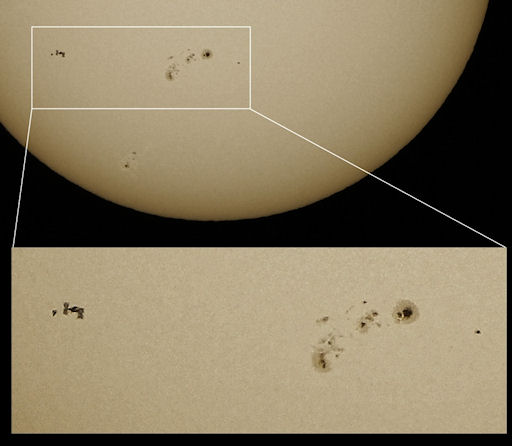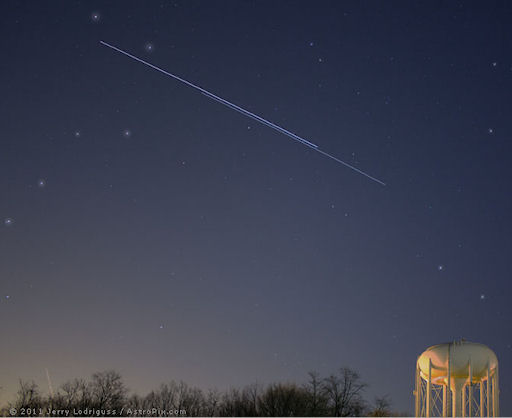Metallic photos of the sun by renowned photographer Greg Piepol bring together the best of art and science. Buy one or a whole set. They make a stellar gift. | | |
FAST CORONAL MASS EJECTION: A coronal mass ejection (CME) exploded from the vicinity of sunspot 1164 during the late hours of March 7th. It lept away from the sun traveling some 2200 km/s, making it the fastest CME since Sept. 2005. A movie of the cloud prepared by Karl Battams of the Naval Research Lab seems to show a small but non-negligible Earth-directed component. This CME and at least one other could brush against Earth's magnetic field on March 9th or 10th. High-latitude sky watchers should be alert for auroras.
SUNSPOT CONJUNCTION: Yesterday, shortly after space shuttle Discovery undocked from the International Space Station, the two ships flew directly in front of the sun over Europe. Catalin Fus of Krakow, Poland, had his solar-filtered telescope trained on sunspot 1166 and recorded this amazing conjunction:

"I was surprised that I could see Discovery flying around the station," says Fus. "The shuttle is so small compared to the ISS." Nevertheless, both silhouettes were clearly visible alongside the sunspot. This was Fus's last chance to see Discovery before the shuttle is retired post-landing on March 9th. What a way to say goodbye.
more transit images: from Jérôme DELPAU of Coemont, Sarthe, France; from Jan Eric Krikke of Heerenveen, The Netherlands; from Pawel Warchal of Cracow, Poland.
DOUBLE FLYBY ALERT: Space shuttle Discovery undocked from the International Space Station on Monday, March 7th, setting the stage for a series of spectacular double flybys. Traveling side by side, the shuttle and station are flying over parts of the USA and Europe where sky watchers can see them shining brightly in the night sky. Jerry Lodriguss sends this picture of the pair from Voorhees, New Jersey:

"Discovery and the ISS passed over New Jersey at 19:00:17 pm ET on March 7th," says Lodriguss. "The shuttle was the fainter of the two, but both were very bright, with Discovery leading the ISS by about 15 seconds."
Flybys like this will continue until Discovery lands on Wednesday, March 9th. Check the Simple Satellite Tracker or your smartphone to find out when to look.
more images: from Tamas Ladanyi of Bakonybel, Hungary; from Marek Nikodem of Szubin, near Bydgoszcz, Poland; from Raymond Kneip of Luxembourg; from Paul Willows of Clifton, Doncaster, UK; from Fabio Rezzonico of Richterswil (Zürich), Switzerland; from Sylvain Weiller of Saint Rémy lès Chevreuse, France; from Edwin Kessler of Millersburg, Pennsylvania; from Radekter of Zdetin, Czech Rep.; from Jin Lu of Tempe, AZ; from Megan O'Leary of Harwich, MA; from Louis Suarato of Albany, New York; from Joe Ricci of Rochester, New York; from Alex Free of Mount Vernon, Washington; from Marko Posavec of Koprivnica, Croatia; from Mark Brunschweiger of Oswego NY; from Geoff Chester of Alexandria, Virginia; from John Sachs of Hanover PA; from Darren Baskill of Rottingdean, East Sussex, England; from Ludek Fik of Kojetin, Czech Republic; from Monika Landy-Gyebnar of Veszprem, Hungary
March 2011 Aurora Photo Gallery
[previous Marches: 2010, 2009, 2008, 2007, 2006, 2005, 2004, 2003, 2002]

